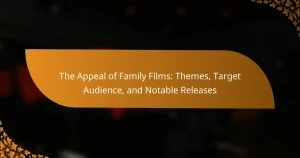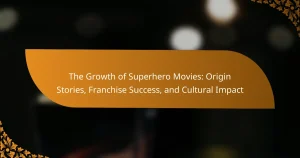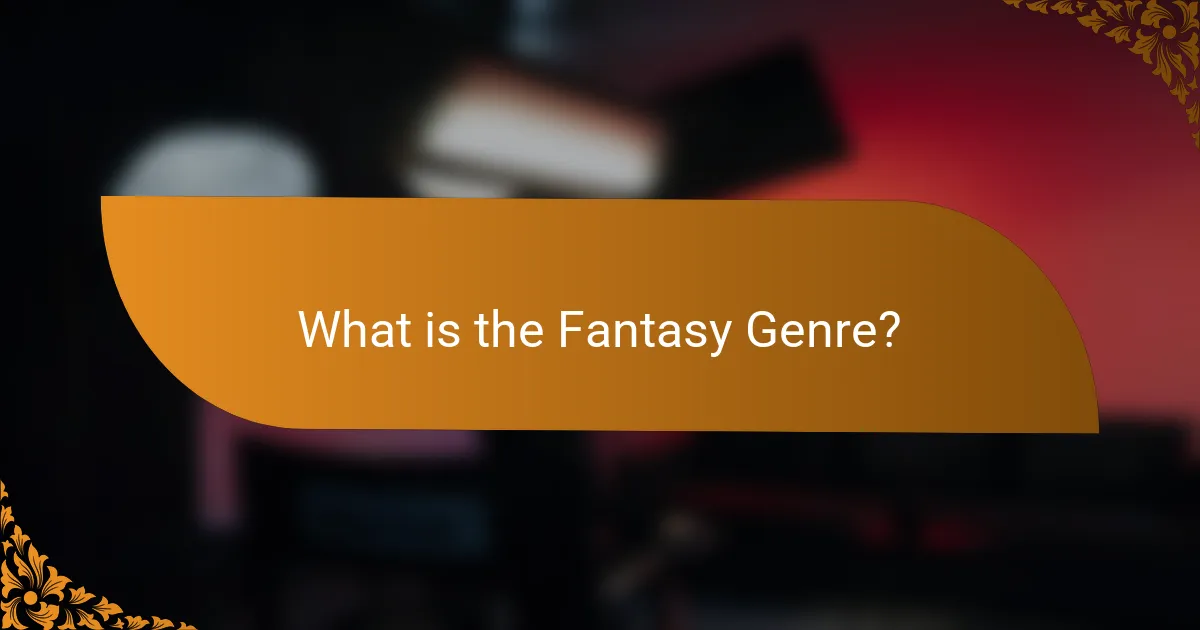
What is the Fantasy Genre?
The fantasy genre is a category of literature that features magical elements and fantastical worlds. It often includes mythical creatures, supernatural events, and imaginary settings. Fantasy narratives frequently involve quests, heroism, and the battle between good and evil. Notable examples include J.R.R. Tolkien’s “The Lord of the Rings” and C.S. Lewis’s “The Chronicles of Narnia.” These works showcase elaborate world-building and rich lore. The genre allows for exploration of themes such as morality, identity, and human experience. Fantasy has roots in folklore and mythology, influencing its narrative structures. The genre has evolved over time, incorporating various sub-genres like urban fantasy and high fantasy.
How did the Fantasy Genre originate and evolve over time?
The Fantasy Genre originated in ancient mythology and folklore. Early stories included gods, mythical creatures, and magical events. These narratives laid the foundation for later literary works. The genre evolved significantly during the Middle Ages with the rise of chivalric romances. Works like “Beowulf” and “The Divine Comedy” incorporated fantastical elements.
In the 19th century, authors like Edgar Allan Poe and George MacDonald expanded the genre. They introduced more complex themes and characters. The publication of “The Hobbit” by J.R.R. Tolkien in 1937 marked a pivotal moment. Tolkien’s work established modern fantasy conventions, including detailed world-building.
The genre continued to grow in the late 20th century. The emergence of series like “The Chronicles of Narnia” and “A Song of Ice and Fire” attracted a wider audience. Today, fantasy encompasses diverse subgenres, including urban fantasy and high fantasy. The genre’s evolution reflects cultural changes and the enduring human fascination with the fantastical.
What are the key historical influences on the Fantasy Genre?
The key historical influences on the Fantasy Genre include mythology, folklore, and classical literature. Mythology provides foundational narratives and archetypes, such as gods and heroes. Folklore contributes local color and cultural themes, reflecting societal values and fears. Classical literature, particularly works like “The Odyssey” and “Beowulf,” introduces epic quests and fantastical elements. Additionally, the Romantic movement emphasized imagination and nature, further shaping fantasy’s themes. The publication of “The Lord of the Rings” by J.R.R. Tolkien in the mid-20th century solidified modern fantasy’s popularity and complexity. These influences collectively established the genre’s core characteristics and narrative structures.
How have cultural shifts impacted the development of the Fantasy Genre?
Cultural shifts have significantly influenced the development of the Fantasy Genre. The genre has evolved alongside societal changes, reflecting contemporary values and concerns. For instance, the rise of feminism in the 20th century led to stronger female protagonists in fantasy literature. Works like “The Dispossessed” by Ursula K. Le Guin showcased complex female characters. Additionally, the increasing interest in diversity has prompted authors to explore varied cultural mythologies. This resulted in a broader representation of characters and settings, as seen in works by authors like N.K. Jemisin. The genre has also responded to technological advancements, incorporating modern themes and settings. The popularity of video games and films has further shaped narrative styles and audience expectations. Overall, cultural shifts have driven the genre to adapt and expand, making it more inclusive and reflective of current societal dynamics.
What are the defining characteristics of the Fantasy Genre?
The defining characteristics of the Fantasy Genre include the presence of magical elements, mythical creatures, and imaginary worlds. These elements create a sense of wonder and escapism. Fantasy often involves quests or adventures that challenge the protagonist. Common themes include good versus evil and the hero’s journey. World-building is a crucial aspect, providing detailed settings that enhance the narrative. Characters may possess supernatural abilities or belong to fantastical races. The genre often draws on folklore, mythology, and cultural traditions. Popular examples include J.R.R. Tolkien’s “The Lord of the Rings” and C.S. Lewis’s “The Chronicles of Narnia.”
What role does imagination play in the Fantasy Genre?
Imagination is central to the Fantasy Genre. It allows authors to create intricate worlds and unique characters. This genre often features mythical creatures and magical elements that defy reality. Imagination enables the exploration of themes like heroism, morality, and adventure. It fosters escapism, allowing readers to experience alternate realities. The richness of detail in fantasy settings relies heavily on imaginative thinking. Classic works like J.R.R. Tolkien’s “The Lord of the Rings” illustrate how imagination shapes vast, immersive worlds. Ultimately, imagination is the driving force that distinguishes fantasy from other genres.
How do themes of good versus evil manifest in fantasy narratives?
Themes of good versus evil manifest in fantasy narratives through clear character archetypes and moral conflicts. Protagonists often embody virtues such as bravery, compassion, and justice. Antagonists typically represent malevolence, greed, and chaos. These characters engage in epic battles that symbolize the struggle between light and darkness.
Fantasy worlds often feature magical elements that enhance this dichotomy. For example, enchanted artifacts may grant power to the righteous or corrupt the wicked. The narrative structure frequently includes quests that test the characters’ morals.
Classic examples include “The Lord of the Rings,” where Frodo’s journey represents the fight against Sauron’s evil. In this narrative, the One Ring symbolizes the corrupting influence of power. Similarly, in “Harry Potter,” the conflict between Harry and Voldemort illustrates the battle between good and evil.
These stories resonate with audiences by reflecting real-world moral dilemmas. They allow exploration of complex themes such as redemption, sacrifice, and the nature of evil. The resolution of these conflicts often reinforces the idea that good ultimately prevails, providing a sense of hope.
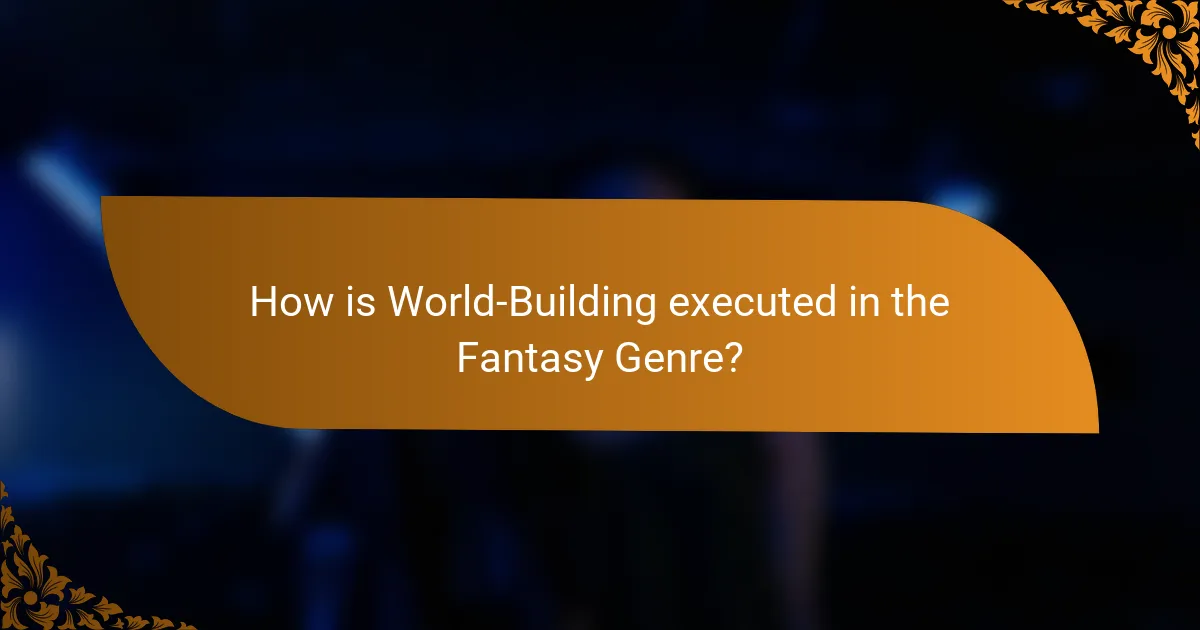
How is World-Building executed in the Fantasy Genre?
World-building in the fantasy genre involves creating detailed and immersive fictional worlds. Authors establish unique settings with distinct geography, cultures, and histories. This process includes defining rules of magic and technology that govern the world. Characters are often influenced by the societal norms and conflicts present in these worlds. Fantasy worlds frequently feature mythical creatures that enhance the narrative’s richness. The integration of lore and mythology adds depth to the setting. Consistency in world-building ensures that readers remain engaged and immersed. Successful examples include J.R.R. Tolkien’s Middle-earth and J.K. Rowling’s Wizarding World. These works showcase intricate world-building that captivates audiences and enhances storytelling.
What are the essential elements of effective world-building?
Effective world-building includes several essential elements. These elements create a believable and immersive setting. Geography shapes the physical landscape and influences culture. History provides a backdrop of events that shape societies. Cultures define the customs, beliefs, and social structures of inhabitants. Magic systems establish rules governing supernatural elements. Political systems create power dynamics and conflicts. Economy outlines trade, resources, and wealth distribution. Character development adds depth to individual experiences within the world. Each of these elements interconnects to enhance the overall narrative.
How do geography and environment shape a fantasy world?
Geography and environment are crucial in shaping a fantasy world. They influence the culture, economy, and social structures of its inhabitants. For instance, mountainous regions often lead to isolated communities with distinct traditions. In contrast, coastal areas may foster trade and cultural exchange. The availability of resources affects the technology and magic systems within the world. Arid environments can lead to nomadic lifestyles, while fertile lands support agriculture and population growth. Weather patterns also dictate the types of creatures that inhabit the world. For example, harsh climates might give rise to resilient species adapted to survive extreme conditions. Ultimately, geography and environment create a foundational backdrop for the narrative and character development in a fantasy setting.
What importance do cultures and societies hold in world-building?
Cultures and societies are crucial in world-building as they provide depth and authenticity to fictional settings. They shape the beliefs, customs, and values of characters within the narrative. Diverse cultures create conflict and resolution, driving plot development. Societal structures influence character interactions and relationships. Historical contexts enrich the backstory of the world. For example, J.R.R. Tolkien’s Middle-earth features distinct cultures like the Elves and Dwarves, enhancing the story’s richness. This complexity allows readers to connect emotionally with the world. Ultimately, cultures and societies are foundational elements that make fantasy worlds believable and engaging.
How do authors create immersive worlds?
Authors create immersive worlds through detailed world-building, character development, and sensory descriptions. They establish unique settings with distinct cultures, histories, and geographies. This depth allows readers to feel part of the environment. Authors often use maps and illustrations to enhance visualization. They also create complex characters with relatable emotions and motivations. This connection draws readers deeper into the narrative. Sensory details like sights, sounds, and smells further enrich the experience. Techniques such as foreshadowing and symbolism create layers of meaning. These elements work together to make the world feel real and engaging.
What techniques are used to develop unique languages and dialects?
Techniques used to develop unique languages and dialects include phonetic design, grammar construction, and vocabulary creation. Phonetic design focuses on the sounds and pronunciation of the language. This involves choosing specific phonemes that reflect the culture of the speakers. Grammar construction establishes rules for sentence structure and verb conjugation. This provides consistency and clarity in communication. Vocabulary creation involves inventing new words that embody cultural concepts and values. These techniques are often employed in fantasy literature to enhance world-building. For instance, J.R.R. Tolkien created Elvish languages with detailed grammar and rich vocabulary. This adds depth to the narrative and immerses readers in the fictional world.
How do authors incorporate history and mythology into their worlds?
Authors incorporate history and mythology into their worlds by weaving historical events and mythological narratives into their storytelling. They create rich backstories that reflect real-world cultures and beliefs. This adds depth and authenticity to their fictional settings. For instance, J.R.R. Tolkien drew from Norse and Anglo-Saxon mythology in “The Lord of the Rings.” Similarly, Neil Gaiman’s “American Gods” blends various mythologies with American culture. These authors use historical references to ground their narratives in reality. They also explore themes of heroism, morality, and the supernatural, which resonate across different cultures. This combination enhances the reader’s immersive experience and connection to the narrative.
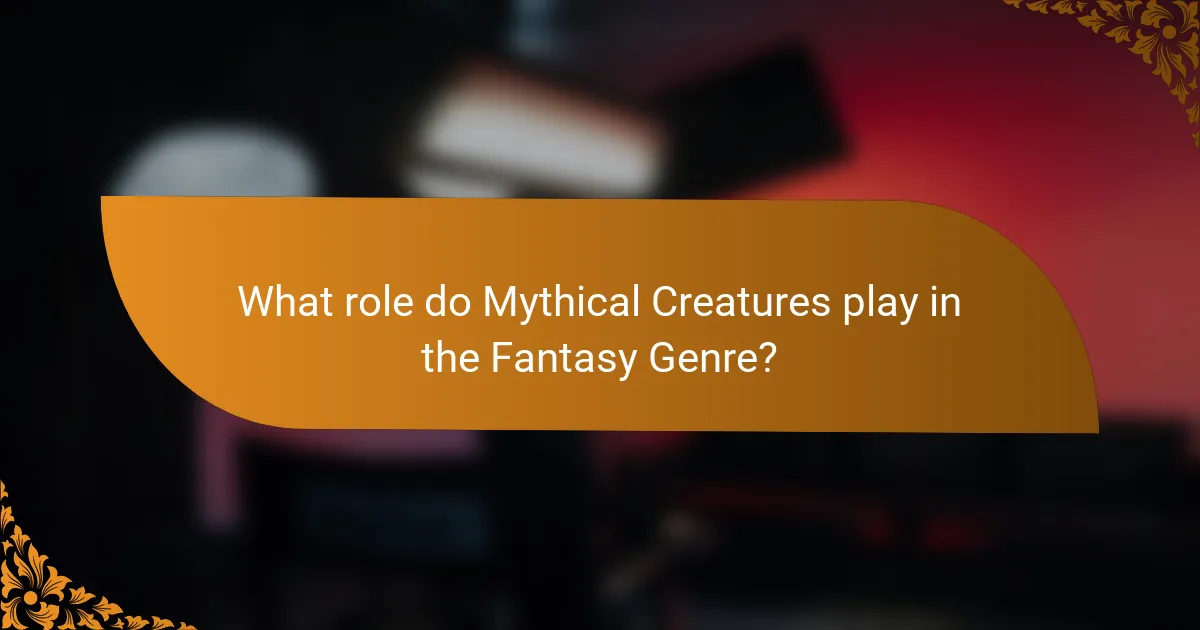
What role do Mythical Creatures play in the Fantasy Genre?
Mythical creatures serve as essential elements in the fantasy genre. They enhance world-building by introducing unique beings that embody cultural myths and legends. These creatures often symbolize various themes, such as good versus evil or the unknown. They provide conflict and challenges for protagonists, driving the narrative forward. Additionally, mythical creatures enrich the lore of fantasy worlds, adding depth and complexity. Their diverse forms, from dragons to fairies, reflect the imagination of authors and the cultures that inspire them. This diversity allows for a wide range of storytelling possibilities. Overall, mythical creatures are integral to the thematic and narrative structure of fantasy literature.
What are the most common types of mythical creatures in fantasy literature?
The most common types of mythical creatures in fantasy literature include dragons, elves, and fairies. Dragons often symbolize power and chaos. They appear in various cultures, from European to Asian mythology. Elves are typically depicted as wise and agile beings, often associated with nature. They are prominent in works like J.R.R. Tolkien’s “The Lord of the Rings.” Fairies are often portrayed as magical and mischievous creatures. They are prevalent in folklore and modern fantasy. Other common creatures include unicorns, griffins, and trolls. Each of these creatures carries unique attributes and cultural significance. Their recurring presence shapes the fantasy genre’s narrative and world-building aspects.
How do these creatures enhance the narrative and themes of fantasy stories?
Mythical creatures enhance the narrative and themes of fantasy stories by embodying symbolic meanings and driving plot development. They often represent human fears, desires, or moral lessons. For instance, dragons can symbolize greed or power, while fairies may represent whimsy or the unknown. Their unique abilities and attributes create conflict and resolution within the story. This conflict often leads to character growth or transformation. Furthermore, these creatures enrich world-building by adding depth and complexity to the setting. They establish a sense of wonder and escapism, engaging readers’ imaginations. Their presence often reflects cultural values and societal norms, providing commentary on real-world issues. In summary, mythical creatures are integral to the thematic fabric of fantasy literature.
What unique attributes do specific mythical creatures possess?
Dragons possess the unique attribute of flight alongside fire-breathing capabilities. These creatures are often depicted as powerful and wise in various cultures. Unicorns have the unique attribute of their single spiraled horn, symbolizing purity and grace. They are frequently associated with healing powers and are often elusive. Mermaids uniquely possess the ability to live both underwater and on land. Their enchanting voices are said to lure sailors, adding to their mystique. Griffins combine the attributes of an eagle and a lion, symbolizing strength and vigilance. They are often depicted as guardians of treasure in mythology. Each of these mythical creatures has distinct traits that contribute to their cultural significance and storytelling in the fantasy genre.
How do mythical creatures reflect cultural beliefs and values?
Mythical creatures embody cultural beliefs and values by representing societal ideals and fears. They often serve as symbols of morality, power, and the human condition. For example, dragons in many cultures symbolize strength and wisdom, reflecting the value placed on these traits. In contrast, creatures like the banshee represent fear and the unknown, mirroring cultural anxieties about death. Additionally, the attributes of these beings often align with the characteristics admired or feared in a society. For instance, the phoenix signifies rebirth and resilience, aligning with cultural values of renewal. Historical texts, such as “Beowulf,” illustrate how mythical beings serve as reflections of the cultural context in which they are created. Overall, mythical creatures act as mirrors to the values and beliefs of the societies that create them.
What are examples of mythical creatures representing different cultures?
Dragons are prominent mythical creatures in many cultures. In Chinese culture, dragons symbolize power and good fortune. They are often depicted as benevolent beings associated with water and agriculture. In European folklore, dragons are typically seen as malevolent creatures representing chaos and destruction. They often guard treasures and are slain by heroes in tales. The Japanese have the Ryū, a dragon that embodies water and is associated with rainfall and agriculture. In Hindu mythology, the Nāga is a serpent-like being that represents fertility and is often linked to water bodies. Each of these creatures reflects the values and beliefs of their respective cultures.
How do these creatures influence the moral lessons within fantasy narratives?
Mythical creatures in fantasy narratives often serve as symbols for moral lessons. They embody traits that reflect human virtues or vices. For example, dragons may represent greed or destruction, while fairies can symbolize kindness and compassion. These creatures often face challenges that highlight moral dilemmas. Their journeys can illustrate the consequences of choices, guiding characters and readers toward ethical conclusions. In many stories, the resolution involving these creatures reinforces the importance of virtues like bravery, loyalty, and selflessness. This narrative technique encourages readers to reflect on their own morals and behaviors. Ultimately, mythical creatures enrich the moral framework of fantasy stories, making lessons more impactful and memorable.
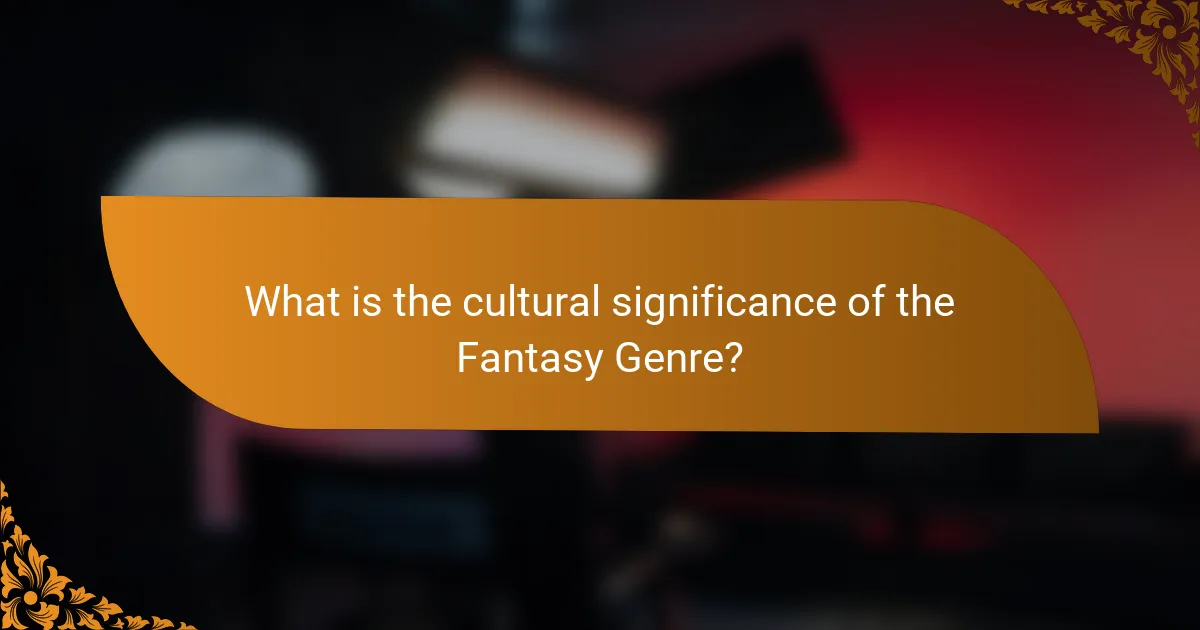
What is the cultural significance of the Fantasy Genre?
The cultural significance of the Fantasy Genre lies in its ability to reflect and shape societal values and beliefs. Fantasy often serves as a mirror to real-world issues, allowing exploration of complex themes such as morality, heroism, and identity. It provides an escape from reality while simultaneously addressing the human condition.
Historically, works like J.R.R. Tolkien’s “The Lord of the Rings” have influenced cultural narratives and inspired various adaptations in film and literature. The genre fosters imagination and creativity, encouraging readers to envision alternate realities.
Additionally, fantasy promotes cultural diversity by incorporating mythologies and folklore from various cultures. This inclusion broadens perspectives and fosters understanding among different communities.
Overall, the Fantasy Genre plays a crucial role in cultural expression, offering a platform for both reflection and innovation.
How does the Fantasy Genre address real-world issues and themes?
The Fantasy Genre addresses real-world issues and themes by using allegory and metaphor. It often reflects societal conflicts, such as war, oppression, and discrimination. For example, J.R.R. Tolkien’s “The Lord of the Rings” explores themes of power and corruption. Similarly, George R.R. Martin’s “A Song of Ice and Fire” examines political intrigue and moral ambiguity. Fantasy can also address personal struggles, such as identity and belonging, as seen in “Harry Potter” with themes of friendship and acceptance. These narratives allow readers to engage with complex issues in a safe, imaginative context. By presenting these themes through fantastical elements, the genre encourages critical thinking and empathy towards real-world situations.
In what ways do fantasy narratives serve as social commentary?
Fantasy narratives serve as social commentary by reflecting societal issues and cultural norms. These stories often depict struggles between good and evil, mirroring real-world conflicts. They can critique political systems, as seen in works like “The Hunger Games,” which explores class disparity and authoritarianism. Fantasy also allows for the exploration of identity, as characters often face quests that challenge societal expectations.
Moreover, the use of mythical creatures can symbolize marginalized groups, highlighting themes of acceptance and diversity. For instance, orcs and elves in “The Lord of the Rings” represent different cultures and their interactions. Additionally, fantasy worlds can exaggerate real-world problems, making them more visible and approachable.
Through allegory and metaphor, fantasy invites readers to question their realities. This genre often serves as a safe space for discussing taboo subjects, such as war and discrimination. Overall, fantasy narratives use imagination to critique and reflect on the complexities of society.
How can fantasy literature promote diversity and inclusion?
Fantasy literature can promote diversity and inclusion by featuring a wide range of characters and cultures. This genre often creates worlds that reflect various human experiences. By incorporating diverse protagonists, authors can challenge stereotypes and broaden perspectives. Inclusive narratives allow readers to see themselves represented in different roles. Studies show that representation in literature can enhance empathy and understanding. For example, works like “The Poppy War” by R.F. Kuang draw from Chinese history and culture. Such stories provide visibility to underrepresented groups. This fosters a sense of belonging among diverse readers. Ultimately, fantasy literature can serve as a platform for dialogue about social issues.
What impact does the Fantasy Genre have on popular culture?
The Fantasy Genre significantly influences popular culture. It shapes storytelling across various media, including literature, film, and video games. Iconic works like J.R.R. Tolkien’s “The Lord of the Rings” have inspired countless adaptations. These adaptations often introduce fantasy elements into mainstream narratives. The genre also fosters creativity and imagination, encouraging new forms of artistic expression. Furthermore, fantasy conventions and fan communities promote social interaction and cultural exchange. The success of franchises like “Harry Potter” demonstrates its commercial impact, generating billions in revenue. Overall, the Fantasy Genre continuously shapes cultural trends and societal values.
How have fantasy adaptations influenced film and television?
Fantasy adaptations have significantly influenced film and television by expanding narrative possibilities and visual storytelling techniques. These adaptations often introduce intricate world-building elements that captivate audiences. For example, “The Lord of the Rings” trilogy set a new standard for epic storytelling and special effects in cinema. The success of such adaptations has led to increased investment in high-quality productions. Television series like “Game of Thrones” have showcased complex character arcs and moral ambiguities, attracting a broad viewership. Additionally, fantasy adaptations have popularized diverse mythologies and cultures, enriching the genre’s depth. The rise of streaming platforms has further accelerated this trend, allowing for more ambitious fantasy projects. Overall, fantasy adaptations have reshaped audience expectations and industry standards in film and television.
What role do fan communities play in the popularity of the Fantasy Genre?
Fan communities significantly enhance the popularity of the Fantasy Genre. They create a space for discussion and engagement around fantasy works. This interaction fosters loyalty among fans and attracts new audiences. Online platforms allow fans to share theories, artwork, and fan fiction. Such contributions expand the universe of the original works. Events like conventions further strengthen community bonds. These gatherings promote networking and shared experiences. Research shows that fan engagement can lead to increased sales and media adaptations. For instance, the success of franchises like “Harry Potter” and “The Lord of the Rings” is partly due to active fan communities.
What are best practices for engaging with the Fantasy Genre?
Best practices for engaging with the Fantasy Genre include immersing oneself in world-building. Detailed settings enhance the reader’s experience. Readers should explore diverse mythical creatures to understand their significance. Engaging with cultural elements deepens the narrative. Participating in discussions about themes enriches comprehension. Analyzing character development reveals deeper connections. Reading widely within the genre exposes various styles and approaches. Attending conventions or workshops fosters community engagement. These practices enhance appreciation and understanding of fantasy literature.
How can readers choose the right fantasy books for their interests?
Readers can choose the right fantasy books by identifying their specific interests within the genre. First, they should consider subgenres such as epic fantasy, urban fantasy, or magical realism. Each subgenre has distinct themes and settings that cater to different preferences. For example, epic fantasy often involves grand quests and detailed world-building, while urban fantasy blends magical elements with contemporary settings.
Next, readers can explore author styles and tones. Some authors focus on character development, while others emphasize plot or world-building. Familiarity with an author’s previous works can guide choices.
Additionally, readers should look at book reviews and recommendations from trusted sources. Websites like Goodreads and book blogs provide insights into popular titles and reader experiences.
Finally, participating in fantasy book clubs or discussion groups can help readers discover new books aligned with their interests. Engaging with a community allows for sharing personal preferences and receiving tailored suggestions.
What tips can enhance the experience of exploring fantasy worlds?
Immerse yourself in the lore of the fantasy world. Understanding the backstory enhances appreciation of the setting. Engage with the characters to create emotional connections. This connection deepens the experience of the narrative. Explore the world through multiple mediums. Books, films, and games provide diverse perspectives. Participate in community discussions to gain insights. Engaging with other fans broadens understanding and enjoyment. Use imagination to visualize the settings and creatures. This personal interpretation makes the experience more vivid.
The main entity of the article is the Fantasy Genre, which encompasses literature featuring magical elements, mythical creatures, and imaginative worlds. The article provides an overview of the genre’s origins, evolution, and key historical influences, highlighting its defining characteristics such as world-building and themes of good versus evil. It examines the role of mythical creatures, cultural significance, and how fantasy narratives address real-world issues, promoting diversity and inclusion. Additionally, the article discusses the impact of fantasy on popular culture, adaptations in film and television, and best practices for engaging with the genre.
